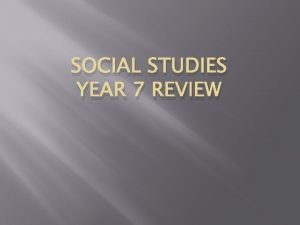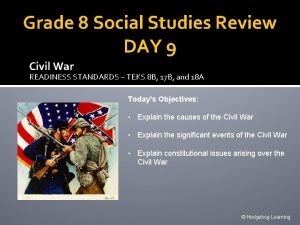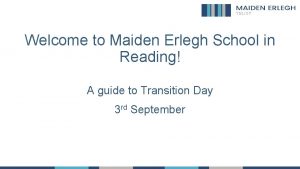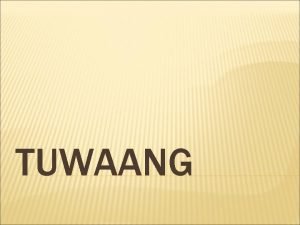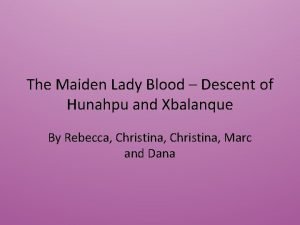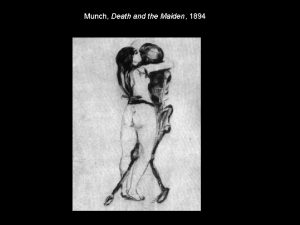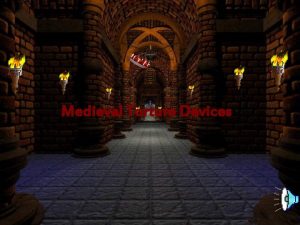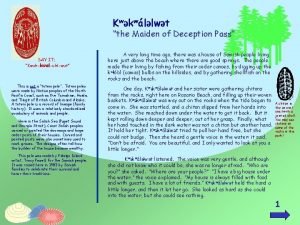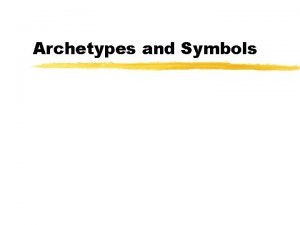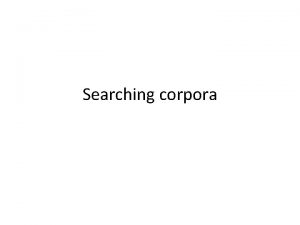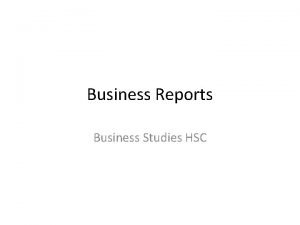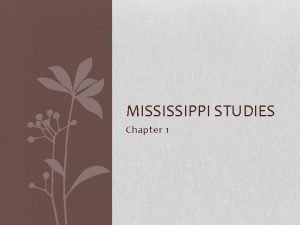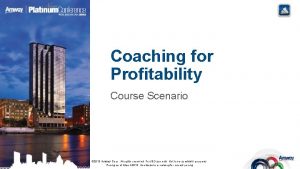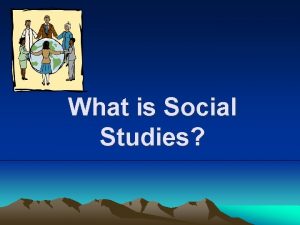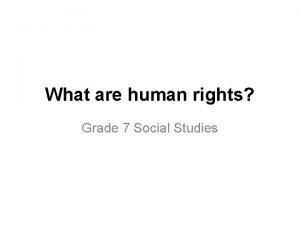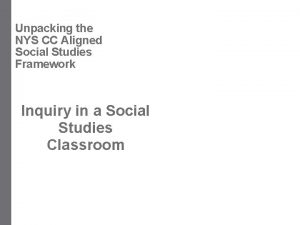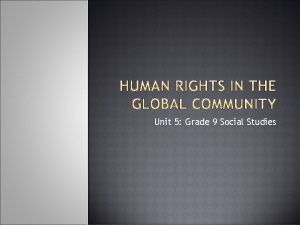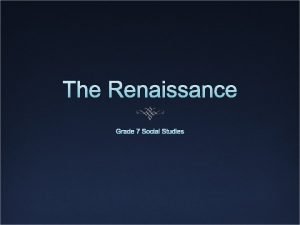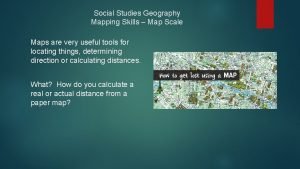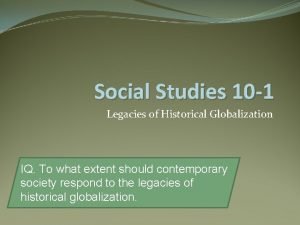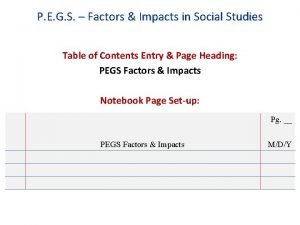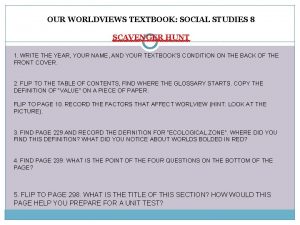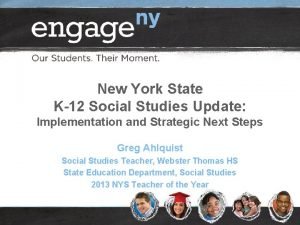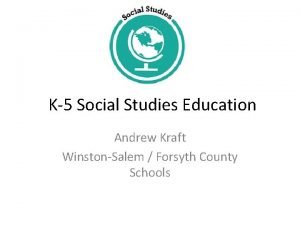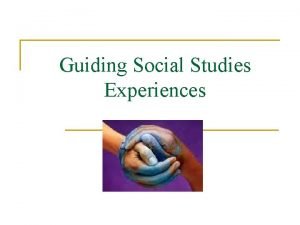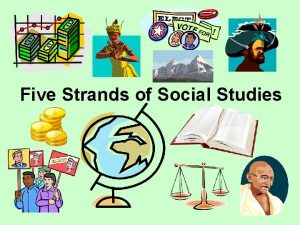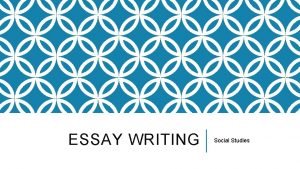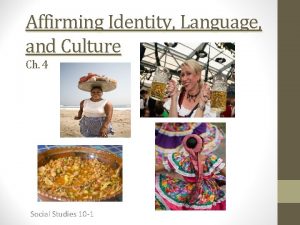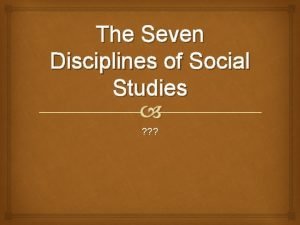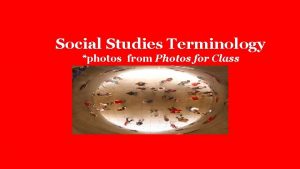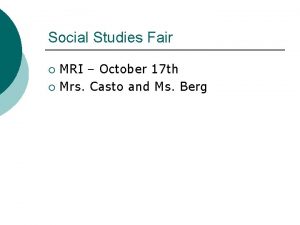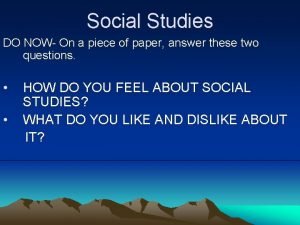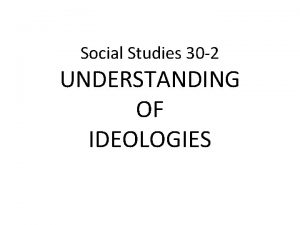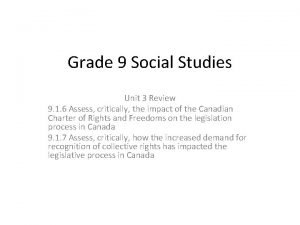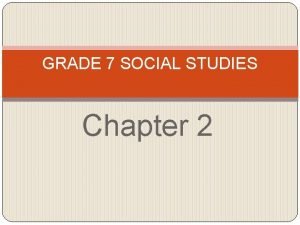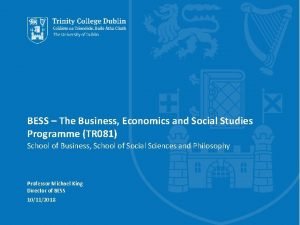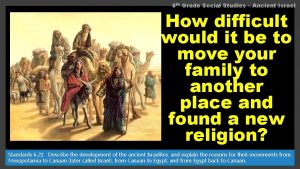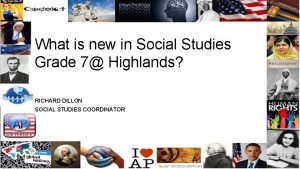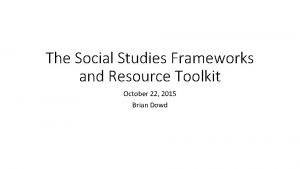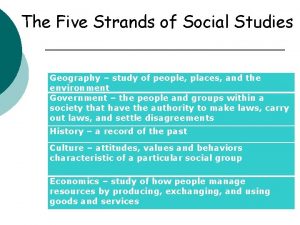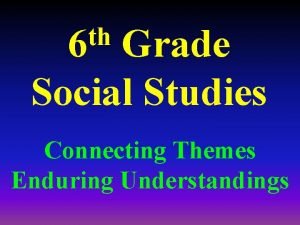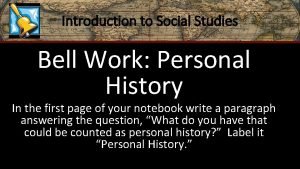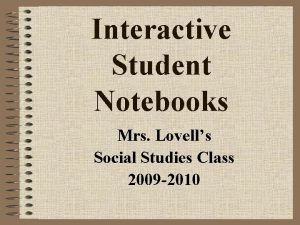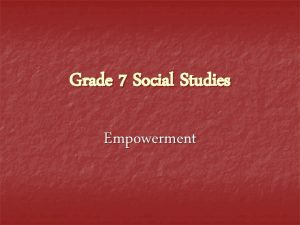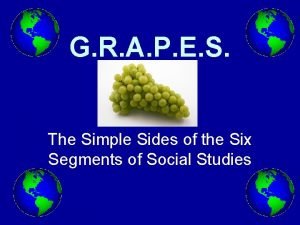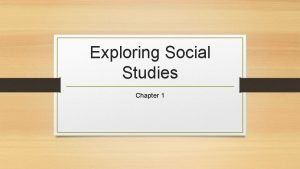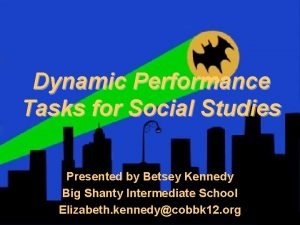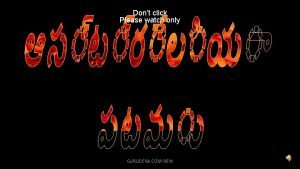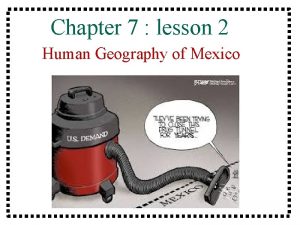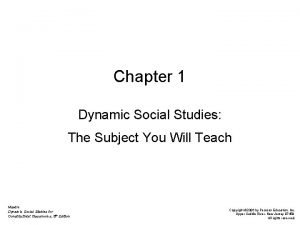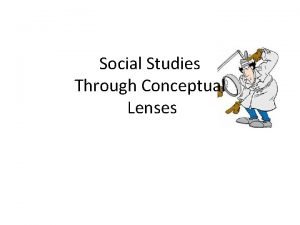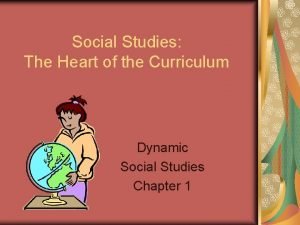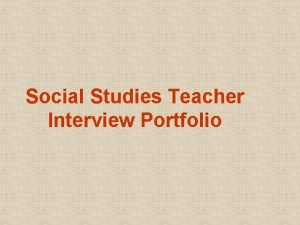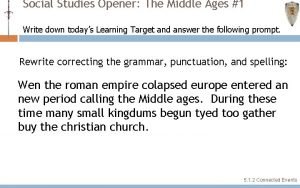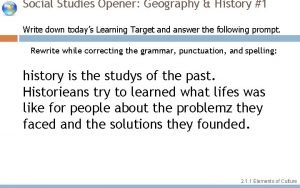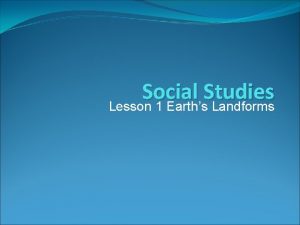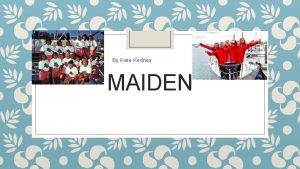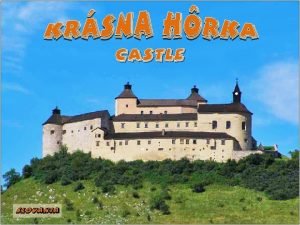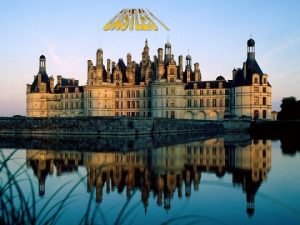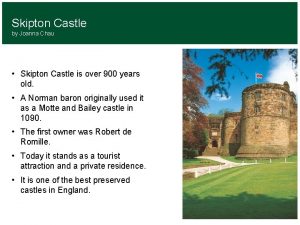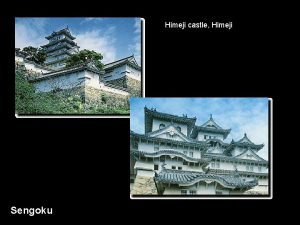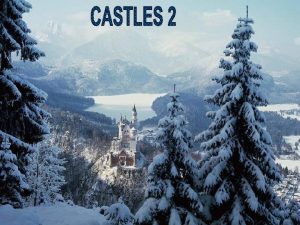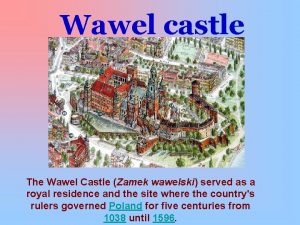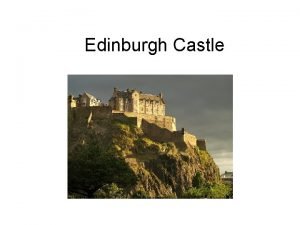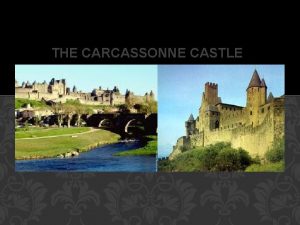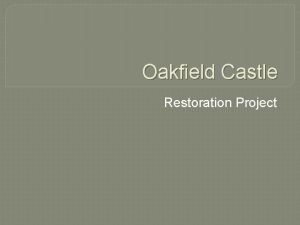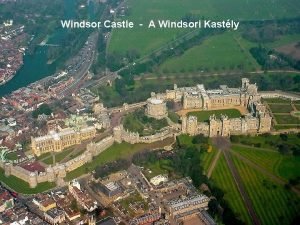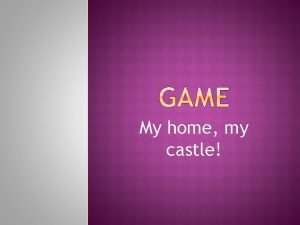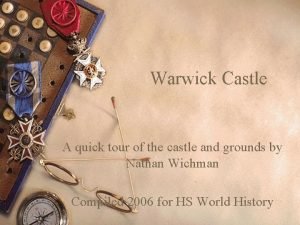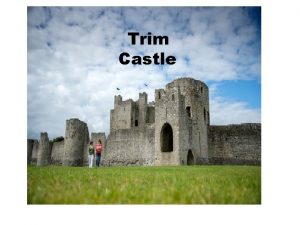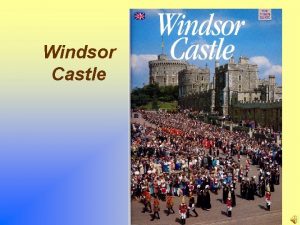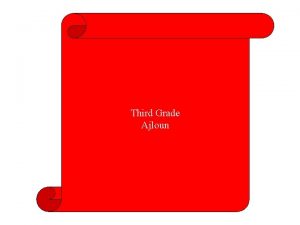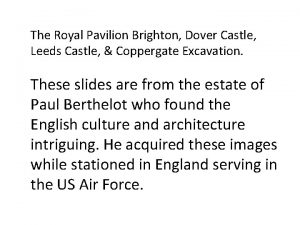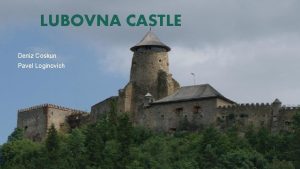SOCIAL STUDIES YEAR 7 REVIEW Maiden Castle 3











































































- Slides: 75

SOCIAL STUDIES YEAR 7 REVIEW

Maiden Castle (3) A hillfort built by the Durotriges tribe in the South of England. It had large sloping earthen walls, which formed a maze around the fort. The defenders would shoot slingshots at their enemies from the ramparts (the upper walls). It was eventually captured by the Romans after AD 43, when they invaded and conquered Britain. The Romans used a weapon called the ballista.

Durotriges (3) �A Celtic tribe in Iron Age Briton that was based around the area of Maidan Castle.

Ballista (5) A long-distance weapon similar to the catapult. It fired a long iron bolt and was used by the Romans, especially during sieges.

Hypothesis (6) �A prediction based on available evidence

Source (8) � Anything from the past that tells us more about what happened. For example, documents (written sources), pictures, buildings, artefacts (objects) and even skeletons.

Iron Age Britain (10 -11) � � � Between 800 BC-43 AD Iron Age Britain consisted of numerous tribes (the Durotriges, Belgae etc. ) Each tribe was ruled by a separate chieftan Iron Age Britons were pagans, which means they worshiped the sun, moon and stars (nature) We have very little information about Iron Age Briton because they did not write anything down!

Roman Age Britain (12 -13) � � � Between 43 AD-430 AD Britain was conquered by the Emperor Claudius of the Roman Empire in 43 AD The Romans built large villas, forums, colosseums, bathhouses, aqueducts, roads, and sewers and developed the country The Romans were pagans and worshipped many gods, including Jupiter (Zeus) While the Romans came from Italy and spoke Latin, the Britons continued speaking their own language

Saxon Age Britain (14 -15) � � � Between 430 AD-1066 AD The Roman military retreated from Britain in order to defend Rome from barbarians Warriors from Northern Europe, the Saxons (Germany), Jutes (Denmark), and Angles (Netherlands) arrived in Britain Many Vikings from Scandinavia invaded and settled parts of Britain Although people in the Saxon Age were originally pagan, the country slowly converted to Christianity The language spoken was Old English, which was similar to German (the Saxons came from Germany)

Norman Age Britain (16 -17) � � Begins in the year 1066 AD with the conquest of Britain by Duke William of Normandy The Normans came from Northern France and were originally Vikings who settled in France, eventually speaking French and converting to Christianity The Normans built many castles to rule the country and built many churches The Normans originally spoke French, but eventually mixed it with Old English to produce the modern English we understand today

The Middle Ages (500 AD-1500 AD) � � � The Middle Ages is a period in history between 500 AD and 1500 AD The Middle Ages is famous for: The Feudal System (King, Nobles, Knights, Peasants) A period in time between the Fall of Rome (in the 400 s) and the Renaissance and Protestant Reformation (in the 1500 s) The Saxon Age and the Norman Age in Britain are part of the Middle Ages

Medieval � Anything having to do with the Middle Ages � For example: Medieval times Medieval jobs Medieval history Medieval people � �

Timeline/Chronology (18 -19) �Putting people and events in the correct sequence in time �Includes using the correct names for periods of history

Anachronism (27) � Something that does not belong in a particular time period � For example: A cell phone in Saxon Britain, or William the Conqueror in Roman Britain

Archaeology �The study of human history and prehistory by digging up sites and studying artefacts and other physical remains

Empire (Roman Empire) (28 -29) � � An extensive group of countries and territories ruled by a supreme power, such as an Emperor The Roman Empire comprised many countries and peoples. Spain, France, Italy, Greece, Turkey, Egypt, Palestine, Tunisia, and Morocco were all part of the Roman Empire.

Legionary (30 -31) � � � A heavily armed Roman foot soldier armed with a javelin, sword, dagger and shield. They were paid well and would receive a pension or a small farm upon retiring. Legionaries came from all over the Roman Empire They were highly disciplined, and could form into a tortoise-like formation called the ‘Testudo, ’ which is Latin for ‘Turtle. ’

Hadrian’s Wall A large defensive wall built by the Roman Emperor Hadrian in the year 122 AD in order to protect Roman Britain from the Picts. The Picts were barbarians living in what is now Scotland.

Roman People (Diocles) (36) � � Diocles was a great Roman charioteer. A charioteer could become famous and rich, but it was dangerous! Diocles used to be a slave but was able to buy his freedom due to his wealth and popularity

Roman People (Lollia) (38) � � Even though many Romans were free, some lived in poverty. Lollia was a laundry girl who had to clean sheets in a vat of urine. She lived in a rickety apartment that could collapse at any moment.

Roman Technology (Aqueduct) A tunnel that carried water from the mountains to the city in ancient Rome

Roman Technology Baths of Caracalla Romans built many bathhouses. They used a technology called the hypocaust to bring heated water in pipes up to the baths. The largest bathhouse was built by the Emperor Caracalla.

The Roman Colosseum A huge amphitheatre that featured gladiators that would fight to the death for the entertainment of the crowds. This was one of the ways the Roman Emperors would entertain and distract everyday people.

The 5 Saxon Kingdoms � � � There were 5 Kingdoms in Anglo. Saxon England: Northumbria Mercia East Anglia Wessex Kent

The Vikings � � � The Vikings were a warrior-people from Scandinavia (present-day Denmark, Norway and Sweden) Around the year 800 AD, the Vikings arrived in England as raiders. They would use their ships known as ‘longboats’ to attack monasteries and towns and steal their gold Many Vikings eventually settled in England in an area called the Danelaw

Viking Longboat Vikings used longboats to sail along the coast and to other countries in order to trade, and also to conduct raids (attack) on villages and monasteries. Longboats were very fast and could sail on the open sea as well as up rivers.

Monastery � � � A monastery is a group of religious buildings where monks work and pray Monasteries are sometimes isolated and in faraway places Monasteries were famous for their large libraries and collections of books and treasures Monks would work day-and-night to copy religious books Monasteries were sometimes attacked by Vikings, such as the Lindesfarne Monastery in 791 AD

King Alfred of Wessex (15) � � King Alfred was the King of Wessex He was famous for driving out the Vikings

The Norman Conquest (56 -57) � � � In 1066, an army led by William Duke of Normandy (also known as William the Conqueror) arrived in England William wanted to claim the throne of England become King of England William successfully conquered England after the Battle of Hastings, in October 1066

William the Conqueror � � � William, Duke of Normandy (also known as William the Conqueror) was the ruler of Normandy, in the north of France His cousin was King Edward the Confessor of England. When Edward died, William wanted to become King, but had to fight Harold Godwinson for the throne William was known as a cruel ruler, who starved many of his own people in the Harrying of the North

King Harold Godwinson � � � Harold Hardrada was the richest man in England claimed that Edward the Confessor promised him the throne of England before he died According to the Bayeux Tapestry and Guillaume of Jumieges, Harold promised he would help Duke William become King of England after William had saved his life in France, but Harold denied this He was killed at the Battle of Hastings with an arrow through the eye

Harard Hardrada � � The King of Norway who also had a claim to the English throne He invaded England defeated the English at Fulford Hardrada then fought the English again at the Battle of Stamford Bridge, but was defeated by Harold Godwinson’s forces Out of hundreds of ships, only a couple dozen were needed to take the survivors back to Norway

Bayeux Tapestry (60 -63) � The Bayeux Tapestry is a woven piece of cloth with images depicting the Norman Conquest of 1066. It resembles a medieval comic book

Harold Swears to William In this image, Harold Godwinson swears to William on a box of reliquaries (a golden container containing the holy bones of a saint) that he will support William to become King. Harold had been in France and had fought alongside Wililam as friends, and William saved his life (according to the Bayeux Tapestry) so in return he promised to help William. Harold Godwinson later denied he ever promised he would help William become King.

A comet in the sky In the Bayeux Tapestry, a comet is seen in the sky as Harold Godwinson claims the throne. This comet was seen as an evil omen and a sign that Harold should NOT be king. Since the Bayeux Tapestry was commissioned (created) by the Normans and shows the Norman perspective, we know that the Normans believed that Harold should NOT be king.

The Battle of Stamford Bridge � � � The Battle of Stamford Bridge was a great victory by King Harold Godwinson against Harald Hardrada in the north of England. It was the 2 nd English battle against the Norwegians (the 1 st being the Battle of Fulford) However, King Harold’s army was weakened after the battle and had to march a great distance in order to fight William at Hastings. Historians believe that William won at Hastings largely because Harold’s army was so weak after having fought at Stamford Bridge.

The Battle of Hastings was the final and most important battle of the Norman Conquest. In ended with the death of King Harold Godwinson. Duke William of Normandy was then crowned King of England The Normans were famous as knights and horsemen, and you can see the Normans on the left-hand side of the image on horseback

� � John of Worcester and Guillaume of Jumieges (66 -69) +Bias John and William were monks that wrote about the Norman Conquest and the Battle of Hastings from the English perspective (John) and the Norman perspective (Guillaume) respectively Both authors were BIASED: John focused on Harold’s bravery in battle and tried to explain that Harold’s army was weak because of the Battle of Stamford Bridge. Guillaume focused on Harold’s oath to William (his promise to support William in his bid to win the throne) and did not mention Stamford Bridge at all.

Bias � � Telling one side of the story while ignoring other perspectives of the story Example: Guillaume of Jumieges was Norman and told the story so that the reader feels that William should be the rightful king of England (that Harold swore an oath to him). Guillaume was biased towards the Normans and biased against the English.

Harrying of the North (75) � � � After several rebellions in the north of England, William discovered that rebels in the area of York and Durham were receiving weapons and aid from the Danes. William attacked the rebels in the north, driving away the Danish army and crushing the rebels. As punishment, he burned all the farms in the area around York and Durham, and 100000 people starved to death. The innocent and guilty were punished just the same. This was called the Harrying of the North-’Harry’ means to ravage or destroy.

The Domesday Book (81) � � � The Domesday Book was a record of the property and land in each village and town in England William wanted to keep track how many animals and how much land people owned so that he could tax people more effectively It was called the Domesday Book because people compared it to the Book of Judgment in heaven

Hereward the Wake’s Rebellion (76 -79) � � Hereward was from a wealthy family in Peterborough. When the Normans decided to steal the treasure from Peterborough Abbey, Hereward took action by hiding the treasure at his hideout on the Island of Ely, located in a deep swamp The Normans eventually surrounded the island Hereward was forced to surrender. Hereward escaped but many of his men were tortured and killed by William as punishment.

5 ways that William changed England (72 -73) � � � Land: He gave land to his most loyal supporters such as Robert de Montain that he stole from English lords Castles: He built Motte-and-Bailey castles all over England to control his territory Hunting Laws: He stopped the English from hunting in their own forests by imposing terrible punishments Language: The nobility and the most important people in the country had to speak French, the language of the Normans Churches: The Normans built magnificent cathedrals

Types of Castles: Motte-and-Bailey (82 -83) Built in the 11 th century (1000 s) It was made of wood and hundreds were built by William the Conqueror in order to protect his soldiers and to control the land of England The Motte is the top section of the castle. It is a large tower on an earthen mound surrounded by a fence The Bailey is the lower section of the castle. It features barracks (soldiers’ quarters), a blacksmith, stables, and a small chapel.

Types of Castles: Keep (82 -83) Typically built in the 12 th century (1100 s) Keeps were made of stone. This made them largely impervious to fire. In the centre of the keep is where the lord and his soldiers lived. A keep could be destroyed by digging a tunnel underneath the keep and then burning wood with pig fat in the tunnel, which would cause the stones to collapse. This was done by King John during the Siege of Rochester in 1215.

Types of Castles: Concentric Typically built in the 13 th and 14 th centuries (1200 s-1300 s) The castle defences featured walls within walls, so that if attackers managed to get through one wall, they would be trapped with a second set of walls in front of them. Concentric castles featured a moat, which was designed to impede access to the walls as well as to prevent tunnels from being dug

Types of Castle: Residential � � � Typically built in the 15 th century (1400 s) and after Castles were no longer used for defence since cannons could easily smash a castle to bits Used as a home (residence) for rich people, Tattershall Castle had wide staircases, wooden floors, multiple entrances, and luxurious rooms.

Knights (85) � � � Mounted soldiers (on horseback) Knights were typically arrayed (dressed) in plate-mail armour Being a knight was quite expensive and only wealthy people could become knights. A knight would have a squire, whose job was to clean his armour and serve him Knights would get land from a lord in the form of a fief and would be in charge of managing the peasants when not fighting in wars After the Battle of Agincourt (among other wars), knights became unpopular since they were easily killed in battle by the longbow, and later, by firearms. Knights either became nobles, or freemen.

Feudal Pyramid A system of social organization in the Middle Ages that created responsibilities for each of the 4 classes in society: The King at the top, the nobles, the knights, and finally the peasants at the bottom.

King John and the Magna Carta (106 -111) � � � Read pages 106 -111 about King John and the Magna Carta King John was an English King whose nicknames were “Lackland” and “softsword. ” John was upset over the fact that his older brothers had been given land by their father while John did not receive any. Thus the name “lackland. ” When John became King, he became obsessed with winning back territory in France that his father had conquered but that John had lost. John raised taxes to fight wars in France, but these taxes were raised unfairly and it upset the barons. However, he kept losing wars in France, thus the name “softsword. ”

Reasons the barons hated King John (107 -111) � � � John refused to take the barons advice on important matters John used the courts to arrest people he did not agree with or like He did not trust the barons and took advice from foreign mercenaries, such as Gerald d’Athee, whom he gave 3 castles he took from English barons John argued with the Pope, which led to an interdict that prevented burials and marriages within England until John apologized John kept taxing the barons and yet kept losing wars in France with the money he was taxing John taxed the people unfairly: -He increased the fines people had to pay in the courts -He charged rich widows as much as 3000 pounds for the right to stay unmarried after their husbands died He increased the tax people had to pay when they inherited their parents’ land -He massively increased taxes on barons who refused to provide soldiers for him, and even imprisoned a baron when he refused to pay �

The Magna Carta (110) � � � � Clause 1: The English Church shall be respected. The King must not interfere with the Church. Clause 2: When a baron inherits land he shall not pay tax. Clause 8: No widow shall be forced to pay tax as long as she wishes to live without a husband Clause 12: The king must not demand taxes without reason Clause 39: No freeman shall be arrested or imprisoned without cause Clause 51: All foreign mercenaries must leave the country. Clause 61: The barons shall choose 25 barons to make certain the king keeps this charter. If he breaks the charter, the 25 barons can take action to make him keep it. They can take his castles and lands but must not attack the King, his Queen or his children.

Which clause was the most important? Which clause did John hate the most? � � The most important clause of the Magna Carta is up to you! But clause 39 -No freeman shall be arrested or imprisoned without cause is very important today because it protects innocent people from getting punished by the government John hated clause 61 the most, because he would have to listen to 25 barons in order to make any decisions. John wanted to make all decisions himself without anybody else’s opinion or help.

Worst Jobs in the Middle Ages (part 1) � � � Squire: Had to serve a knight by cutting his food and washing his armour with a mixture of sand urine Leach Collector: Collected leaches for barbersurgeons, who used them to suck the ‘bad blood’ out of their patients Barber-Surgeon: Performed amputations (cut off limbs), performed bleedings (removing blood to get rid of disease), applied leaches, and would even taste the urine of a patient to see what kind of illness they had.

Worst Jobs in the Middle Ages (part 2) � � � Medicine Woman: Was much cheaper to visit than the barber-surgeon. Cut up eels, worms, and other disgusting creatures to make into medicine. These cures usually did not work, and medicine women could often be accused of witchcraft (being witches) and get punished Treadmill worker: A worker on a construction site that walked in a large, round treadmill in order to bring blocks of stone to the top of a church or castle under construction Fuller: Removed the grease from unfinished cloth by putting the cloth in a vat of urine and then stomping up and down on it for hours. The fuller also had to go doorto-door to collect urine from the villagers.

Punishments in the Middle Ages (148 -149) There were no policemen in the Middle Ages � Ordinary people kept watch in the village � Punishments included: -The stocks: Getting vegetables thrown at you so you look foolish -A fine: You pay money to the lord -Hanging: These hangings took place in public and were big events that attracted crowds -Trial by ordeal: If they did not know you were guilty or innocent, they let God decide. A person would have to carry a hot metal bar. If his/her hands healed, they were allowed to go free, but if their hands did not heal, they were guilty and then punished �

Did people try to keep clean? (144 -145) � � � There was soap in the Middle Ages (made from sheep fat mixed with wood ash and caustic soda) but only the rich could afford it Table manners were quite poor (a book written in 1200 said that you can only urinate in the hall if you are the lord) In the 1000 s (11 th century) cities and towns were filthy places where people threw their garbage out on the streets and rats were everywhere (and could spread the Black Death). By the 1300 s, cities were much cleaner.

Did people have fun in the Middle Ages? (134 -135) � � � People often engaged in archery (shooting a bow and arrow). It was good practice! And kings kept making laws banning football so that people would practice their skills with the bow. Almost nobody could read (except monks) so people listened to travelling entertainers telling them about King Arthur or Robin Hood Poor people drank ale, which was a weak beer. It was often much cleaner than the water, which could have bacteria and make people sick.

THE BLACK DEATH (168 -177) � � � YOU NEED TO KNOW: The causes of the Black Death (168) How the Black Death spread (168) The symptoms (169) The victims (169) Attempted remedies (176 -177)

The Black Death (the Aftermath) (172 -173) � � � After the Black Death, most of the peasants had died. Since there were few peasants to do the work, the peasants wanted a) permission to leave the village to find work, and b) wanted higher wages since nobody else was around to do the work The lord (such as Sir Robert Lovell) did not free the peasants (villeins) and they became more and more upset until they rose up during the Peasants’ Revolt.

The Peasants’ Revolt (178 -179) � � Villagers in Essex refused to pay taxes and attacked the tax collectors They freed a priest named John Ball from prison, who was arrested for saying all men should be equal and free The rebel leader was Wat Tyler. His rebels burned down the Duke of Lancaster’s house and killed the Archbishop of Canterbury Wat Tyler was eventually killed in battle but King Richard promised the peasants they would become freemen (he broke this promise later)

Thomas of Walsingham and Bias (180 -181) � � How does Thomas of Walsingham show bias against the rebels in his account? He calls the rebels ‘stupid, ’ ‘rascals, ’ ‘ruffians, ’ ‘arrogant. ’ etc. Thomas also describes the crimes of the rebels in detail: the burning of the Duke of Lancaster’s home, how the rebels threatened to kill the king while holding him hostage, how the rebels made ugly ‘kissy-faces’ to the king’s mother, and how the rebels killed the archbishop of Canterbury. Thomas also describes how poorly armed the rebels were, with swords ‘covered in rust’ and ‘arrows with only one feather. ’

Was Thomas correct about the rebels? (182 -183) � � Thomas did NOT mention important information Thomas did NOT talk about the Statute of Labourers, which was a law that said that everybody had to work in the same villages and for the same wages as before the Black Death. He also did NOT say that the Duke of Lancaster raised a Poll Tax, that punished the poor and made them pay the same amount as the rich. He also did NOT mention that many of the rebels were actually wealthier people, or that many of the peasants had good horses and weapons (they had been fighting the French during the war and had these things)

The Wonders of Baghdad (158165) � � � The Islamic world in the Middle Ages was more advanced than Europe in some ways: Baghdad contained the round city, which contained magnificant palaces and mosques. The city was full of canals that allowed goods to be transported effectively as well as keep the city clean. Waste could easily be removed from the city because of the canals. In Europe, cities were still quite dirty, with people throwing waste out of the windows. There were many wealthy homes built of sun-dried bricks, and with large courtyards with fountains, gardens, and fruit trees. In Europe, homes were typically built of wood and did not feature such beautiful gardens. In the markets, it was possible to purchase goods from India, Arabia, China, Egypt, Turkey, Russia and other regions. These goods included wild animals such as tigers and elephants, musical instruments, and even slaves. Trade in Europe was less developed and some goods (especially spices and certain foods) were not available. The system of education was excellent in Baghdad. There was the ‘House of Wisdom, ’ where Islamic scholars translated Greek and Roman texts into Arabic, and where they had great medical and scientific knowledge. The hospitals at the time were more developed than in Europe.

The Battle of Agincourt part 1(86 -87) � � The Battle of Agincourt took place in the Late Middle Ages in the year 1415, in northern France. The English army of King Henry V had been fighting the French in the Hundred Years’ War. Henry V’s army was blocked by the French, but even though Henry only had about 1000 soldiers with no cavalry (no knights) and no crossbowmen, he beat a much larger French army of about 8000 soldiers. HOW DID THE ENGLISH DO IT?

The Battle of Agincourt part 2 (86 -87) � � � The English soldiers used the longbow, which could shoot up to 275 meters and could fire up to 12 arrows per minute. The arrows could penetrate the armour of the French knights. The French knights charged the English lines, but the English hid their longbowmen behind a fence of sharp stakes. The French knights smashed into the fence and many were killed. Others were shot by the longbowmen. The Battle of Agincourt made the knight effectively useless against long-distance weapons such as the longbow, and later, guns. Knights gradually disappeared, and became either freemen or nobles.

The Protestant Reformation part 1 (196 -197) � � � For about 1000 years, all the people in Western Europe had been Catholics. Around 1500, many decided to become Protestant. Eventually, whole parts of Germany, the Netherlands, Scandinavia and England became Protestant. The word Protestant comes from the word ‘protest, ’ because they were protesting against the way the Catholic church was run. The word Reformation comes from the fact that Protestants wanted to ‘reform, ’ or change Christianity.

What did the Protestants want to change? (196 -197) � � Church services and the Bible should be in English (or the language of the people) instead of in Latin because nobody except monks and priests can understand Latin People should be able to choose their own priests instead of having to listen to the Catholic Pope, who is very similar to a king Churches should be plain and simple. Priests do not need to wear fancy gold or ornamentations Catholic priests should not sell indulgences, which are pieces of paper that say that a person can enter heaven

Heretics (197) � The Catholics believed that Protestant ideas were wrong and that Protestants are heretics (a person holding a different opinion or belief than most people). Many Catholics decided they had a duty to stop the Protestants from spreading their ideas. This led to many Protestants being killed, and eventually to wars between Catholic and Protestant countries in Europe.

The Printing Press (200 -201) � � � The printing press was invented in Germany by Johannes Gutenberg in 1450 s. While before the printing press, books had to be copied by hand by scriveners… After the printing press, there were a) far more books and people could afford them, b) more people learned to read, and c) new ideas about medicine, science, history and religion (including Martin Luther’s ideas in the Protestant Reformation) could spread quickly.

GEOGRAPHY 1 � On the exam, you need to know � The five major oceans (Pacific, Atlantic, Indian, Arctic, Southern) The seven continents (North America, South America, Asia, Africa, Europe, Australia (Oceania)) �

GEOGRAPHY 2 � � You will also need to know the four parts of the United Kingdom: England, Wales, Scotland, and Northern Ireland As well as their capitals: London (England), Cardiff (Wales), Edinburgh (Scotland), and Belfast (Northern Ireland) Remember that the Republic of Ireland (capital: Dublin) is a separate country from the United Kingdom. Also, when we say Great Britain, we mean England, Scotland Wales BUT NOT Northern Ireland.

GEOGRAPHY 3 � � � You need to be able to locate the following countries on a map of the Mediterranean, Europe, North Africa, and the Middle East United Kingdom France Germany Denmark (Scandinavia) Italy Spain Egypt Iraq Turkey Palestine

We will use this map to test your geographic knowledge of countries

We will use this map (or similar) to test your knowledge of oceans and continents
 Maiden castle skeletons
Maiden castle skeletons Day 9 grade 8 social studies staar review
Day 9 grade 8 social studies staar review Maiden erlegh school in reading
Maiden erlegh school in reading Tuwaang
Tuwaang Blood of a maiden
Blood of a maiden Five women in the street
Five women in the street Gossip's bridle torture
Gossip's bridle torture Maiden of deception pass
Maiden of deception pass Maiden archetype shadow
Maiden archetype shadow Archetypal colors
Archetypal colors Martha maiden
Martha maiden Grammatical words
Grammatical words Paradigm shift from women studies to gender studies
Paradigm shift from women studies to gender studies Business report structure hsc
Business report structure hsc Leaver poem
Leaver poem Social thinking and social influence in psychology
Social thinking and social influence in psychology Social thinking social influence social relations
Social thinking social influence social relations 4th grade va studies sol
4th grade va studies sol Mississippi studies
Mississippi studies Mid year budget review
Mid year budget review End of year review objectives
End of year review objectives Amway 50/150
Amway 50/150 Mid year budget review
Mid year budget review Absolute location meaning
Absolute location meaning What is living together in social studies
What is living together in social studies What is rights in social studies
What is rights in social studies Nys standards social studies
Nys standards social studies Moral social and cultural studies grade 9
Moral social and cultural studies grade 9 Renaissance definition social studies
Renaissance definition social studies Social studies notebook cover
Social studies notebook cover What is scale in social studies
What is scale in social studies Grand exchange social
Grand exchange social Apa itu tradisi citizenship transmission
Apa itu tradisi citizenship transmission Pegs in social studies
Pegs in social studies Our worldviews
Our worldviews Engage ny.org
Engage ny.org Kas standards
Kas standards Wsfcs social studies
Wsfcs social studies The importance of social sciences
The importance of social sciences Brain wrinkles answer key
Brain wrinkles answer key Social science strands
Social science strands Social studies essay format
Social studies essay format Affirmation of identity social studies definition
Affirmation of identity social studies definition Disciplines of social studies
Disciplines of social studies Social studies terminology
Social studies terminology Www.wvssfair.com abstract
Www.wvssfair.com abstract Social studies do now questions
Social studies do now questions Social studies 30-2 understanding of ideologies pdf
Social studies 30-2 understanding of ideologies pdf Pe standards michigan
Pe standards michigan Chapter 3 social studies grade 9
Chapter 3 social studies grade 9 Social studies chapter 2
Social studies chapter 2 Tcd bess
Tcd bess Nsms 6th grade social studies.weebly
Nsms 6th grade social studies.weebly Nycdoe social studies scope and sequence
Nycdoe social studies scope and sequence Social studies toolkit
Social studies toolkit 5 strands of social studies examples
5 strands of social studies examples Connecting themes of social studies
Connecting themes of social studies Social studies bellwork
Social studies bellwork Interactive student notebook social studies
Interactive student notebook social studies Integrating science and social studies
Integrating science and social studies Grade 7 social studies empowerment
Grade 7 social studies empowerment Grapes social studies
Grapes social studies G.r.a.p.e.s social studies examples
G.r.a.p.e.s social studies examples Exploring social studies lesson 1 thinking like a historian
Exploring social studies lesson 1 thinking like a historian Grasps performance task examples in social studies
Grasps performance task examples in social studies Gurudeva social studies
Gurudeva social studies Lesson 2 human geography of mexico
Lesson 2 human geography of mexico Dynamic social studies
Dynamic social studies Social subjects
Social subjects 5 lenses of social studies
5 lenses of social studies Why social study is important
Why social study is important Social studies teacher interview questions
Social studies teacher interview questions Project on revolt of 1857
Project on revolt of 1857 Social studies
Social studies Social studies
Social studies Social studies
Social studies
